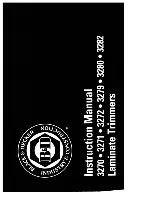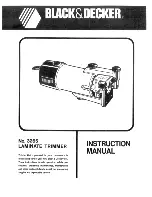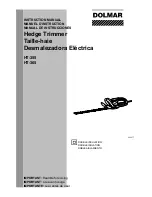
POWDPG7540
EN
Copyright © 2018 VARO
P a g e
|
6
www.varo.com
5.5
Service
▪
Have your power tool serviced by a qualified person using only identical replacement
parts. This will ensure that the safety of the power tool is maintained.
6 ADDITIONAL SAFETY RULES FOR GRASS TRIMMERS
▪
Grass trimmers must not be used by children or untrained persons.
▪
Wear stout shoes or boots to protect your feet.
▪
Wear long trousers to protect your legs.
▪
Check the appliance before use. If it is damaged, it must not be used.
▪
If the unit is damaged, have the damage repaired by an authorized repair agent.
▪
Do not use the appliance in the presence of children and/or animals.
▪
Only use the appliance in daylight or with good lighting.
▪
Never use the appliance without the guard in place.
▪
Before using the appliance, remove sticks, stones, wire and other obstacles from the
surface on which you intend to work.
▪
Only use the appliance in an upright position, with the cutting line pointing to the ground.
Never switch on the appliance in another position.
▪
Always keep your hands and feet away from the cutting line.
▪
Avoid touching the cutting line.
▪
Before putting the appliance down, switch it off and wait for the cutting line to come to a
complete standstill. Never attempt to bring the cutting line to a standstill yourself.
Beware. After switching off the appliance it continues to rotate for a short
time.
▪
Only use the type of cutting line recommended by the manufacturer. Never use a metal
cutting line or fishing line.
▪
After use, always store the appliance safely and out of the reach of children.
7 ADDITIONAL SAFETY INSTRUCTIONS FOR BATTERIES AND
CHARGERS
Use only batteries and chargers applicable for this machine.
7.1
Batteries
▪
Never attempt to open for any reason.
▪
Do not store in locations where the temperature may exceed 40 °C.
▪
Charge only at ambient temperatures between 4 °C and 40 °C.
▪
Store your batteries in a cool dry place (5 °C-20 °C). Never store batteries in discharged
state.
▪
It is better for Li-ion batteries to discharge and reload them regularly (at least 4 times a
year). The ideal charge for long-term storage of your Li-ion battery is 40% of capacity.
▪
When disposing of batteries, follow the instructions given in the section “Protecting the
environment”.
▪
Do not cause short circuits. If connection is made between the positive (+) and negative (-)
terminal directly or via accidental contact with metallic objects, the battery is short circuited
and an intense current will flow causing heat generation which may lead to casing rupture
or fire.
▪
Do not heat. If batteries are heated to above 100 °C, sealing and insulating separators
and other polymer components may be damaged resulting in electrolyte leakage and/or
internal short circuiting leading to heat generation causing rupture or file. Moreover do not
dispose of the batteries in fire, explosion and/or intense burning may result.






























